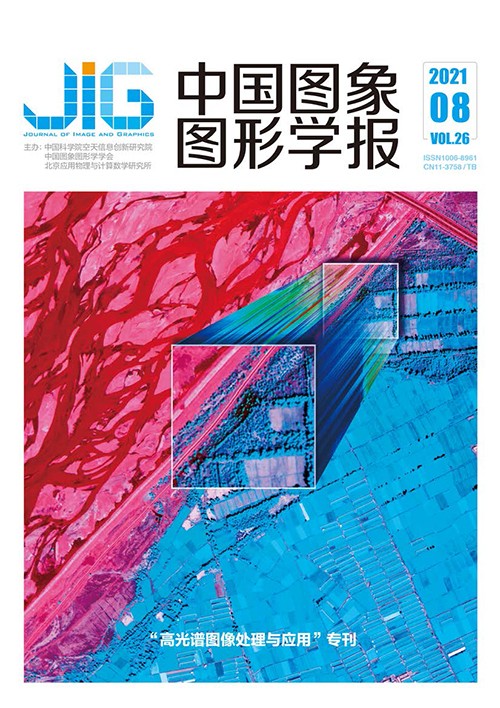
膜性肾病诊断的高光谱图像张量嵌入分析
摘 要
目的 高光谱成像技术因其能够获取目标的详细空间和光谱信息,在医学领域引起了广泛关注。然而,对于识别任务来说,高光谱图像的高维特征通常会导致分类器性能不佳。因此,降维在高光谱图像分析过程中至关重要。为了在低维空间中保留医学高光谱图像的多流形结构信息并增强特征判别能力,本文提出了一种基于张量表示的拉普拉斯稀疏低秩图嵌入方法(tensor-based Laplacian regularized sparse and low-rank graph,T-LapSLRG),用于医学高光谱图像的判别分析。方法 在T-LapSLRG中,基于有标签的张量样本,通过引入稀疏、低秩约束及流形正则项以构造监督张量图。张量表示用于捕获空间结构信息,稀疏和低秩约束用于保留局部和全局结构信息,流形正则项用于利用固有的几何信息并增强特征判别能力。通过引入张量图嵌入技术获取数据的低维特征并输入分类器以实现数据的分类及识别。结果 实验数据采用膜性肾病数据集,通过降维方法获取数据的低维特征,使用支持向量机(support vector machine,SVM)分类器对获取的低维特征进行分类。将T-LapSLRG获得的实验结果与相关的降维方法获得的实验结果进行性能比较,以证明T-LapSLRG算法的有效性。采用4个性能指标,即各个类别的准确性、总体准确性(overall accuracy,OA)、平均准确性(average accuracy,AA)和Kappa系数衡量分类性能。T-LapSLRG在膜性肾病数据集下的OA为97.14%,AA为97.05%,Kappa为0.942,各项性能指标均优于对比方法。其中,OA高出1.40%~34.75%,AA高出1.46%~36.89%,Kappa高出0.031~0.73。此外,通过T-LapSLRG算法获得的各个患者的分类准确率均达到90%以上。结论 T-LapSLRG算法在膜性肾病诊断中具有潜在临床价值。
关键词
Tensor-based graph embedding for discriminant analysis of membranous nephropathy hyperspectral data
Lyu Meng1, Chen Tianhong1, Li Wei1, Yang Yue2, Tu Tianqi2, Li Wen'ge2(1.School of Information and Electronics, Beijing Institute of Technology, Beijing 100081, China;2.Department of Kidney Disease, China-Japan Friendship Hospital, Beijing 100029, China) Abstract
Objective Hyperspectral imaging systems have become promising auxiliary diagnostic tools for intelligent medicine in recent years, especially in disease diagnosis and image-guided surgery. Hyperspectral image (HSI) has hundreds of contiguous narrow spectral bands from visible to infrared electromagnetic spectrum. These bands provide a wealth of information to distinguish different chemical composition of biological tissue. The reflected, fluorescent, and transmitted light from tissue captured by HSI carry quantitative diagnostic information about tissue pathology. Wealthy spectral bands also contain redundancy, which not only degrades classification performance but also increases computational complexity. Thus, dimensionality reduction (DR) needs to be conducted to reveal the essence of data by discarding redundant information. However, most of the current DR methods are based on spectral vector input (first-order representation) that ignores important correlations in the spatial domain. Although some spectral-spatial joint technologies have been investigated to overcome this disadvantage, they still consider the spectral-spatial feature into first-order data for analysis and ignore the cubic nature of hyperspectral data. Thus, a novel tensor-based Laplacian regularized sparse and low-rank graph (T-LapSLRG) for discriminant analysis is proposed to preserve the original intrinsic structure information of medical hyperspectral data and enhance the discriminant ability of features. Method Sparse and low-rank constraints are suggested in the proposed T-LapSLRG to exploit local and global data structures while tensor analysis is developed to preserve the spatial neighborhood information. Multi-manifold is utilized to enhance the discriminant ability and describe the intrinsic geometric information. Consequently, the proposed method not only can preserve local and global structure information but also can utilize the intrinsic geometric information. Thus, it offers more discriminative power than existing tensor-based DR methods. Vector-based methods treat each pixel as an independent and identically distributed item. By contrast, the samples in T-LapSLRG are represented in the form of a third-order tensor that can preserve the original spatial neighborhood information. In addition, only a small set of the labeled training samples is needed by adopting tensor training samples. With the assumption that the samples belonging to the same class lie on a unique sub-manifold, T-LapSLRG constructs tensor-based within-class graph to characterize the within-class compactness for making the resulting graph more discriminative. In summary, T-LapSLRG jointly utilizes spatial neighborhoods and discriminative and intrinsic structure information that capture the local and global structures and the discriminative information simultaneously and make the resulting graph more robust and discriminative. Result To evaluate the effectiveness of the proposed T-LapSLRG, the medical hyperspectral data of membranous nephropathy (MN) is used. The traditional diagnosis methods of MN mainly rely on serological characteristics and renal pathological characteristics, which is tough to reach the intelligent and automated requirements of clinical diagnosis. Two types of MN are used as the experimental verification data, including primary membranous nephropathy (PMN) and hepatitis B virus-related membranous nephropathy (HBV-MN). The microscopic hyperspectral images of PMN and HBV-MN are captured by the line scan hyperspectral imaging system SOC-710 together with the biological microscope CX31RTSF. The SOC-710 system captures 128 spectral bands with 696×520 pixels and a spectral wavelength range from 400 to 1 000 nm. The obtained medical HSI dataset consists of 30 HBV-MN images and 24 PMN images, involving 10 HBV-MN patients and 9 PMN patients. Classification is performed on the obtained low-dimensional features by the classical support vector machine classifier to evaluate the performance of the proposed T-LapSLRG. Four objective quality indices (i.e., individual class accuracy, overall accuracy (OA), average accuracy (AA), and kappa coefficient (Kappa)) are used. The proposed T-LapSLRG outperforms other methods by 1.40% to 34.75% in OA, 1.46% to 36.89% in AA, and 0.031 to 0.73 in Kappa. In addition, the classification accuracy obtained by T-LapSLRG for all patients has reached more than 90%. In clinical diagnosis, the type of disease can be determined when the pixel level accuracy reaches 85% or more. Conclusion In this study, we proposed a novel tensor-based Laplacian regularized sparse and low-rank graph for discriminant analysis. Experiments on the MN dataset demonstrate that the proposed T-LapSLRG is effective in discriminant analysis with sparse and low-rank constraints and multi-manifold, and significantly improves the classification performance. Experimental results verify the nonnegligible potential of T-LapSLRG for further application in MN identification.
Keywords
medical hyperspectral image membranous nephropathy tensor dimensionality reduction(DR) graph embedding
|



 中国图象图形学报 │ 京ICP备05080539号-4 │ 本系统由
中国图象图形学报 │ 京ICP备05080539号-4 │ 本系统由